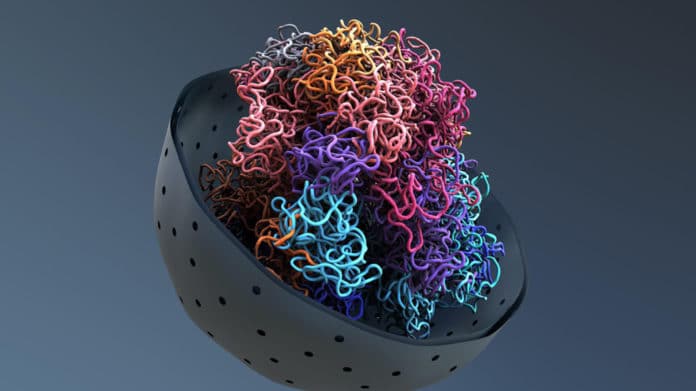In cancer cells, enhancer hijacking mediated by chromosomal alterations and increased deposition of acetylated histone H3 lysine 27 (H3K27ac) can support oncogene expression. However, how the chromatin conformation of enhancer-promoter interactions is affected by these events is unclear.
In a new study, scientists at the EPFL and UNIL used a new algorithmic approach to examine the way cancer cells re-organize the 3D structure of their DNA to increase the activity of cancer-promoting genes called “oncogenes.”
Scientists mainly focused on chromosomes and how they are organized in the tight space of the cell nucleus.
Each cell in our body has about two meters of DNA, so, understandably, we evolved mechanisms to store it properly. This mechanism includes winding DNA around specific proteins called histones, forming a DNA-protein complex is called chromatin.
Several chromatins form the structure of chromosomes. Scientists explored how changes in explicit epigenetic marks modify chromosome structures and the expression of genes that advance tumor growth, known as oncogenes.
Giovanni Ciriello’s team at UNIL developed a novel algorithmic approach called Calder (after the American sculptor Alexander Calder) to track how genomic regions are positioned concerning each other in the nucleus.
“We used Calder to compare the spatial organization of the genome in more than a hundred samples. But this organization is not static and, just like Alexander Calder’s mobile sculptures, it can rearrange its pieces.”
Using Calder, scientists determined the regions of chromatin that “moved” from one area of the nucleus to another due to changing epigenetic marks. These changes were observed in normal and B-cell lymphoma cells.
They found that, particularly in lymphoma cells, some epigenetic changes lead to repositioning in chromatin regions in different areas of the nucleus, promoting local interactions that over-activate the expression of oncogenes.
They also found that when two fragments from different chromosomes are broken off and swapped, they assume a 3D structure that is distinguishable from the normal copies. Importantly, these changes of 3D structure correspond to different epigenetic marks and induce high expression of genes that support tumor cell expansion.
Elisa Oricchio (EPFL) said, “Most of the time, we think of our DNA as a long, linear molecule, and it’s only recently that we started to understand how its 3D organization is altered in cancer cells. Considering the spatial organization of DNA in the nucleus provides a new lens to understand how tumor cells originate, and how therapeutic modulation of epigenetic marks can block tumor progression.”
Journal References:
- Stephanie Sungalee, Yuanlong Liu, Ruxandra A. Lambuta, Natalya Katanayeva, Maria Donaldson Collier, Daniele Tavernari, Sandrine Roulland, Giovanni Ciriello, Elisa Oricchio. Histone acetylation dynamics modulate chromatin conformation and allele-specific interactions at oncogenic loci. Nature Genetics 10 May 2021. DOI: 10.1038/s41588-021-00842-x
- Yuanlong Liu, Luca Nanni, Stephanie Sungalee, Marie Zufferey, Daniele Tavernari, Marco Mina, Stefano Ceri, Elisa Oricchio, Giovanni Ciriello. Systematic inference and comparison of multi-scale chromatin sub-compartments connect spatial organization to cell phenotypes. Nature Communications 10 May 2021. DOI: 10.1038/s41467-021-22666-3
